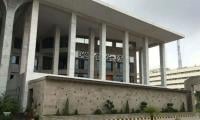ISLAMABAD: The rising price hike has made it difficult for the majority of Pakistanis to afford Dal and Roti for an average household size of their families in the wake of decreased real wages during the outgoing fiscal year.
This correspondent took a sample of average household size of six and a half persons of a family living in the country. The price escalation of essential food items at the retail stage showed that 20 kg wheat-flour price increased from Rs850 to Rs1,125 per bag, Dalda ghee/cooking of 5 kg price went up from Rs1,250 to Rs1,730 per 5 kg, Pulse Mash increased from Rs175 per kg to Rs280 per kg, sugar from Rs65 per kg to Rs100 per kg, rice from Rs140 kg to Rs180 per kg, tea from Rs800 per kg to Rs980 per kg, red chilly Rs300 to Rs350 to Rs 500 per kg, and Pulse Masoor from Rs140 to Rs170 per kg. The estimates of expenses done on average size of over six people on per family basis showed that each family required at least Rs15,000 for affording Dal and Roti as it required at least two bags of wheat-flour, 10 kg ghee/cooking, 5 kg sugar, 3 to 4 kg pulses, 3 kg rice, one kg tea, one kg red chilly, and meeting other pre-requisites for making two-time handi such as vegetables including tomato, onion, green coriander, garlic, ginger, turmeric and many other items.
Then the average family size utility bills, including electricity and gas, could be assumed in the range of Rs5,000 to Rs6,000 on monthly basis. The rent of an average two-bedroom size house in urban/semi-urban areas ranges between Rs5,000 to Rs10,000 on monthly basis. If all these expenditures are taken into account, then the family earning a minimum wage of Rs20,000 cannot afford Dal/Roti on daily basis.
This scribe obtained the official data and talked to economists to ascertain how people are facing fleecing price hike when the real wages virtually declined in Pakistan.
Amid the rising prices of essential food items that have gone up sky high, the real wages of the workforce in Pakistan have declined in the range of 9 percent during the outgoing fiscal year 2020-21, making the lives of common people tougher.
According to official data compiled by the Pakistan Bureau of Statistics (PBS), the prices of chicken increased by 60 percent, eggs 49.7 percent, wheat 27 percent, wheat-flour 26.02 percent, vegetable ghee 25.35 percent, sugar 21.67 percent, rice 11.93 percent, meat 16.3 percent and pulses by almost 30 percent during the first 11 months of the current fiscal year compared to the same period of the last financial year. The prices of potatoes went up by 15 percent, onions 31 percent, tomato 5 percent and fresh vegetables by 12.5 percent during the current fiscal year.
Now the government has announced a 10 percent increase in salaries and pensions of government employees but the CPI-based inflation in the last three years had gone up cumulatively to over 26 percent.
The CPI based inflation on an average stood at 6.8 percent in 2018-19, 10.74 percent in 2019-20 and around 10 percent in the outgoing fiscal year, although, the government is projecting to curtail it at 8.62 percent.
Amid rising general inflation and especially food prices, the government announced jacking up the minimum salary from Rs17,500 to Rs20,000 per month. Pakistan’s inflationary pressures had witnessed an upsurge in recent months mainly because of imports of essential food products and petroleum group. In the aftermath of outbreak of COVID-19 pandemic, the supply of foods got disrupted, so the food prices of imported items witnessed higher trends of prices.
When contacted, former finance minister and economist Dr Hafeez A Pasha said that the real wages in Pakistan declined by at least 9 percent because the government claimed that almost 80 percent of those who lost their jobs got their jobs restored. However, their real wages did not increase. “Our conservative estimates suggest that the real wages in Pakistan declined by 9 percent in the outgoing fiscal year,” he added.
Dr Pasha also pointed out that the construction sector where the government achieved higher growth and economic activities also surged because of PM’s Construction Package but the real wages of the construction sector also declined by 4 to 5 percent.
In the food group, the palm oil prices in US dollar terms have gone up from 706.9 per ton in October 2020 to 848.4 per ton in January 2021, so it witnessed a 20 percent surge in prices. Now the prices of palm oil have further gone up to $950 per ton, so the overall price increase surged by 30 percent. It has resulted in increasing oil/cooking oil prices in the domestic market manifold in recent months for different brands.
The prices of Soybean oil have increased from $708.9 per ton in October 2020 to $1,200 per ton in January 2021 per ton, so it went up by 69.3 percent. It is being used in feed for chicken, so the domestic prices of feed increased from Rs 2,000 to Rs4,000 per bag in the domestic market. The prices of chicken in the domestic market are not coming down from Rs220 per kg.
The refined sugar has gone up from $442.3 per ton in October 2020 to $689.8 per ton in January 2021, so the prices surged by 56 percent. It had resulted in increasing domestic prices and it has now crossed Rs100 per kg mark in the domestic market.
The prices of pulses have increased from $446.2 per ton in October 2020 to $588.7 per ton in January 2021, so the prices became dearer by 32 percent. The price of tea has gone up from $2.1 per ton to $2.2 per ton in the last three months and witnessed a surge by 6.6 percent. When contacted, government functionaries argued that the rising inflation for urban areas was pinching more but the food and commodity prices transferred hefty amounts into rural areas in the last three years. While comparing with the last five years, they said that the rural areas got hefty amounts as the prices of commodities had gone up and rural areas received around Rs1.7 trillion against over Rs375 billion in the last five years of PMLN government.
KP CM Gandapur accused federal government of adopting an unfair attitude towards KP and vowed not to compromise on...
Blinken raised the matter during five-and-a-half hours of talks with China’s top diplomat Wang Yi in Beijing
The chief minister directed the sports minister to review the prospects of cooperation with the delegation
According to Geo News, the Sunni Ittehad Council is second in the National Assembly and PPP occupies the third place
PM has directed Secretary Cabinet Division to take necessary foolproof measures to prevent leakage of agenda and...
The meeting concluded with the agreement on the next steps for commencement of the process of digitalisation of...







